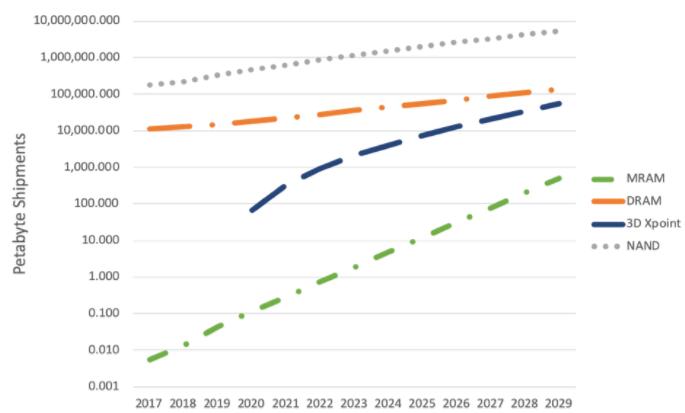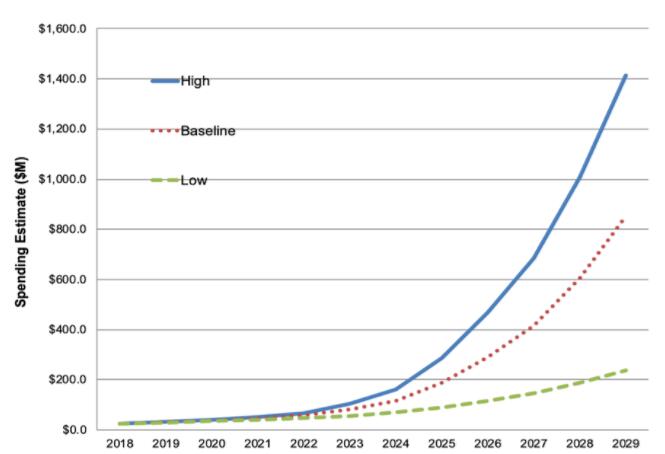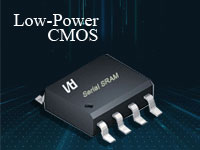Emerging memory market revenues to reach $ 20 billion by 2029
Objective Analysis and Coughlin Associates said that by 2029, the revenue of the emerging memory market will reach $ 20 billion, which will bring the revenue of the emerging memory manufacturing equipment market to $ 854 million.

MRAM Capacity Shipment Forecast (2017-2029, Coughlin)
According to the "Emerging Memory Upgrade" report provided by Objective and Coughlin, the market will grow by replacing the currently inefficient NOR flash and SRAM memory, and will also replace part of the DRAM market. Emerging memory will be used both as a stand-alone memory chip and as embedded memory in other chips such as microcontrollers, ASICs and even computing processors. Future processes will shrink, and improvements in economies of scale will drive down prices, which will allow emerging memories to more effectively compete with today's most popular volatile and nonvolatile technologies.
The report specifically studies MRAM and STT-MRAM technologies, saying that its revenue will increase 170 times from 2018 to 2029, reaching nearly $ 4 billion in revenue. In fact, MRAM memory will enjoy the strongest growth among all emerging storage technologies. In terms of capacity, shipments are expected to grow from approximately 0.1 PB in 2019 to nearly 1 million PB in 2029.

MRAM Equipment Expenditure Forecast (2018-2029, Coughlin)
This report examines PCM, ReRAM, FRAM, and MRAM as well as various secondary mainstream technologies, explaining everyone's competitive advantages and disadvantages. This detailed publication is a total of 171 pages, providing a complete 1242 maps and 30 tables, including embedded memory on the SoC, independent emerging memory chips such as MRAM and ReRAM, 3D XPoint Memory, and high capital equipment expenditures. Baseline and low forecasts. Forecast new equipment needed to support this transition.

MRAM Capacity Shipment Forecast (2017-2029, Coughlin)
According to the "Emerging Memory Upgrade" report provided by Objective and Coughlin, the market will grow by replacing the currently inefficient NOR flash and SRAM memory, and will also replace part of the DRAM market. Emerging memory will be used both as a stand-alone memory chip and as embedded memory in other chips such as microcontrollers, ASICs and even computing processors. Future processes will shrink, and improvements in economies of scale will drive down prices, which will allow emerging memories to more effectively compete with today's most popular volatile and nonvolatile technologies.
The report specifically studies MRAM and STT-MRAM technologies, saying that its revenue will increase 170 times from 2018 to 2029, reaching nearly $ 4 billion in revenue. In fact, MRAM memory will enjoy the strongest growth among all emerging storage technologies. In terms of capacity, shipments are expected to grow from approximately 0.1 PB in 2019 to nearly 1 million PB in 2029.

MRAM Equipment Expenditure Forecast (2018-2029, Coughlin)
This report examines PCM, ReRAM, FRAM, and MRAM as well as various secondary mainstream technologies, explaining everyone's competitive advantages and disadvantages. This detailed publication is a total of 171 pages, providing a complete 1242 maps and 30 tables, including embedded memory on the SoC, independent emerging memory chips such as MRAM and ReRAM, 3D XPoint Memory, and high capital equipment expenditures. Baseline and low forecasts. Forecast new equipment needed to support this transition.
CONTACT US
USA
Vilsion Technology Inc.
36S 18th AVE Suite A,Brington,Colorado 80601,
United States
E-mail:sales@vilsion.com
Europe
Memeler Strasse 30 Haan,D 42781Germany
E-mail:sales@vilsion.com
Middle Eastern
Zarchin 10St.Raanana,43662 Israel
Zarchin 10St.Raanana,43662 Israel
E-mail:peter@vilsion.com
African
65 Oude Kaap, Estates Cnr, Elm & Poplar Streets
Dowerglen,1609 South Africa
E-mail:amy@vilsion.com
Asian
583 Orchard Road, #19-01 Forum,Singapore,
238884 Singapore
238884 Singapore
E-mail:steven@vilsion.com
